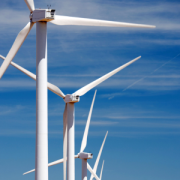AMPLIFY VOL. 36, NO. 3

Fifty years ago, when I was in high school and my science teacher asked me whether the amount of carbon in the atmosphere was a constant, the answer should have been “yes.” Today, that is no longer the case. The amount of carbon in the atmosphere is increasing due to greenhouse gas emissions that absorb the planet’s thermal radiation and are heating its four components (atmosphere, hydrosphere, lithosphere, and biosphere).
It is evident that crossing the 2ºC threshold of global warming would expose humankind to serious health and safety challenges. Everyone is aware of the problem: the World Economic Forum’s “Global Risks 2023 Report” clearly states that the climate issue, with its environmental catastrophes and extreme weather events, is the highest risk for humanity in the coming decade, with biodiversity loss and ecosystem collapse following closely behind.1
This situation means implementation of the United Nations Framework Convention on Climate Change (UNFCCC) Paris Agreement must begin as soon as possible. The agreement requires systemic change using a wide range of solutions, of which renewable energy is one of the most attractive. Clean, green (land-based) or blue (water-based) energy sources must replace our dependence on fossil fuels to reduce at least one of today’s planetary risks.
This is hardly a simple task. Moreover, if it’s done without proper consideration of ecosystems and potential loss of biodiversity, it could cause more harm than good.
This article looks at the current push to ramp up offshore wind farms, including new regulations and technology improvements. It then considers the negative environmental consequences that could result from moving too fast to build offshore wind farms in highly biodiverse areas like the Mediterranean. Although this article focuses on possible negative environmental results from wind-energy projects in a specific area, similar issues must be considered when planning any large-scale renewable energy project anywhere on the planet.
2 Drivers: Technology & Government Directives
The European offshore wind farm sector is expanding rapidly, in part due to new technology. There are two main types of marine wind farms: fixed and floating. Fixed structures have been in use for a while and have been widely deployed in areas such as the North Sea.2 Their infrastructure and footprint prevent them from being installed in deep or complex seabed locations.
Using new technology, wind turbines can be installed on floating platforms anchored to the seabed with catenaries, chains, steel cables, and flexible anchors. This opens the door to placing wind farms farther offshore in areas with higher wind potential, making them more efficient. The companies promoting these structures say they have a lower environmental impact than fixed structures (this has yet to be proven) and are easier to manufacture and install.
Another reason for European offshore wind farm expansion is the EU‘s goal of becoming climate neutral by 2050. The EU estimates that 30% of its energy demand will be supplied by offshore wind by 2050, increasing offshore wind capacity from a current amount of 14.6 gigawatts to 300 gigawatts. This would mean multiplying the marine space allocated to wind energy by 15.3 Experts at BloombergNEF predict that one in every nine new offshore wind turbines could be placed on a floating foundation by the mid-2030s.4
Directive (EU) 2018/2001, on the promotion of the use of energy from renewable sources, has placed considerable pressure on member states. As a result, the North Sea is becoming an energy powerhouse as nearby countries seek to meet their renewable energy targets. Offshore wind farm development in the Mediterranean is still in its infancy, but that situation is changing quickly.
Overall Impact
The impact on the fishing industry, ocean organisms, physical and chemical oceanography, and coastal communities from current and planned European offshore wind farms has just begun to be studied but is expected to be significant.5,6 Environmental impacts can occur in any of five wind-energy development phases: preconstruction, construction, operation (including maintenance), repowering, and decommissioning.
From available studies, we can conclude that: (1) impacts on ecosystems and biodiversity will not be negligible, (2) the risks posed to marine ecosystems are diverse, and (3) assessment of potential project impacts must be done on a case-by-case basis, at least until a more substantial body of research comes out.
To address possible conflicts between offshore wind farm development and biodiversity protection, the EU in 2014 launched the Maritime Spatial Planning Directive (2014/89/EU).7 It placed a legal requirement on member states to develop and implement maritime spatial plans (MSPs) by 2021 at the latest.
However, the EU’s 2018 climate-neutral directive caused many member states to accelerate their renewable energy plans, including building offshore wind farms. This caused some disconnects. First, offshore wind farm guidance documents are still weak, especially for floating structures.8 Second, MSPs must also now incorporate a key recommendation from the UN Conventions on Climate Change and Biological Diversity, which states that solutions designed to address the climate issue should not make another biodiversity-related issue worse.9 This is the purpose of the EU’s Do No Significant Harm (DNSH) principle: solutions to one crisis cannot worsen others.
Thus, developing comprehensive MSPs for large-scale offshore wind farms has become quite complex. At a minimum, they require:
-
Assessing how existing plans balance energy requirements with other spatial interests, support coexistence, and manage related conflicts
-
Taking new planning challenges resulting from large transnational scenarios into consideration
-
Identifying requirements for transboundary planning and cooperation at the sea-basin scale in a context of ecosystem management, cumulative effects, energy security, and transnational infrastructure and policy development
-
Assessing in the best way possible offshore energy’s relation to biodiversity protection, as set out by the International Council for the Exploration of the Sea’s Working Group for Marine Planning and Coastal Zone Management10
Considering Marine Protected Areas
One extremely important consideration for offshore wind farm development is marine protected areas. This includes Natura 2000 sites, a network of core breeding and resting sites for rare and threatened species that stretches across all 27 EU countries (and beyond).
Current EU guidance on wind-energy developments states that when offshore wind projects, whether located inside or outside a Natura 2000 site, are likely to have a significant effect on sites connected to Natura 2000 areas, developers must: (1) pre-assess the relationship(s) between the wind farm and the marine projected area, (2) conduct an appropriate assessment of the site’s conservation objectives to know whether the project will affect the site’s integrity, and (3) explore whether the project is in the public interest based on findings.
EU guidance clearly states that every project must be evaluated on these three areas. Today, offshore wind farms in the German North Sea serve as an example of successful site selection incorporating marine use change.11
Clearly, the EU has excellent intentions when it comes to protecting its sea spaces. The European Commission states that spaces designated for offshore energy exploitation must be compatible with biodiversity protection, incorporate socioeconomic consequences for sectors relying on the good health of marine ecosystems, and integrate other uses of the sea as much as possible.12
But time is running out, and industry demands to accelerate offshore wind farm projects may impede the ability of local governments to conduct appropriate assessments regarding impacts on marine protected areas.
Considering the Mediterranean Sea
Apart from pilot projects in France, there are currently no offshore wind farms in operation in the Mediterranean. However, that situation is likely to change, as MSPs have already been published, raising concerns about possible effects on marine wildlife and ecosystems already being affected by activities like commercial fishing, cargo ships, recreational watercraft, and aquaculture.
Of great concern is the fact that the narrow continental shelf and steep bathymetry in many parts of the Mediterranean mean that most offshore wind projects will need to be developed close to the coast, where there is strong wind power. Unfortunately, this area has a large number of marine-protected areas, making it extremely difficult to balance wind-energy needs with biodiversity goals.
For example, Spain has almost 3,100 miles of coastline. The offshore wind industry is understandably interested in making the Iberian Peninsula its European hub, and the Spanish government is eager to use wind energy to help it transition away from fossil fuels.
Recently, an area off the Spanish coast was opened to the offshore wind industry for development. Six companies have proposed projects to develop 1 gigawatt of wind-sourced electricity in this area, designated as LEBA-1.
Some of the companies are established corporations with stated sustainable policies; some are new companies with no mention of sustainability on their websites. This is important because LEBA-1 is completely surrounded by marine protected areas. Some of these areas are the most biodiverse in the Mediterranean Sea region.13 Without careful consideration of potential ecosystem disruption and biodiversity concerns, an influx of offshore wind farms in this location could be environmentally disastrous.
Avoiding that disaster requires an emphasis on awarding project permissions to companies with: (1) a strong understanding of how the ocean affects companies and companies affect the ocean14 and (2) a commitment to corporate sustainability that includes meeting business goals without compromising the ability of natural systems to provide the resources and ecosystem services on which our well-being depends.
Conclusion
Europe’s transition away from fossil fuels must certainly include alternative energy systems like offshore wind power. At the same time, the EU is committed to keeping critical ecosystems functioning and protecting biodiverse areas.
This means all new offshore wind farms, including floating farms, should be subject to:
-
MSP regulations, including careful strategic environmental assessments of all plans
-
An appropriate assessment of a site’s conservation objectives if an offshore wind farm outside a Natura 2000 site is likely to have a significant effect on protected sites
-
An environmental impact assessment showing compatibility with marine strategies (to be carried out before an operational license is granted)
In the Mediterranean and other coastal areas around the world, renewable energy developments should never be considered within marine protected areas, ecologically valuable areas for sensitive species, or connectivity corridors.
Instead, companies seeking to build fixed or floating wind farms must adopt nature positive strategies that recognize the systemic transformation required for the future.
References
1 “The Global Risks Report 2023.” 18th edition. World Economic Forum, January 2023.
2 “Development of Wind Farm Areas in Europe.” European Environment Agency, 29 June 2015.
3 Wilson, Alex Benjamin. “Offshore Wind Energy in Europe.” European Parliamentary Research Service (EPRS), November 2020.
4 “Wind — 10 Predictions for 2022.” BloombergNEF, 28 January 2022.
5 Lloret, Josep, et al. “Unravelling the Ecological Impacts of Large-Scale Offshore Wind Farms in the Mediterranean Sea.” Science of The Total Environment, Vol. 824, June 2022.
6 “Working Group on Offshore Wind Development and Fisheries (WGOWDF).” International Council for Exploration of the Sea (ICES), 22 December 2022.
7 “Directive 2014/89/EU of the European Parliament and of the Council of 23 July 2014 Establishing a Framework for Maritime Spatial Planning.” Official Journal of the European Union, 28 August 2014.
8 European Commission, Directorate-General for Environment. “Guidance Document on Wind Energy Developments and EU Nature Legislation.” EU, 2021.
9 “WWF’s Position on Offshore Renewable Energy and Nature.” WWF, 20 May 2021.
10 “Working Group for Marine Planning and Coastal Zone Management.” International Council for the Exploration of the Sea (ICES), accessed March 2023.
11 Kannen, Andreas, and Benjamin Burkhard. “Integrated Assessment of Coastal and Marine Changes Using the Example of Offshore Wind Farms: The Coastal Futures Approach.” GAIA — Ecological Perspectives for Science and Society, Vol. 18, No. 3, 2009.
12 Lloret et al. (see 5).
13 “Key Biodiversity Areas: Keep Nature Thriving.” Key Biodiversity Areas (KBA), accessed March 2023.
14 Nash, Kirsty L., et al. “Planetary Boundaries for a Blue Planet.” Nature Ecology & Evolution, Vol. 1, October 2017.



